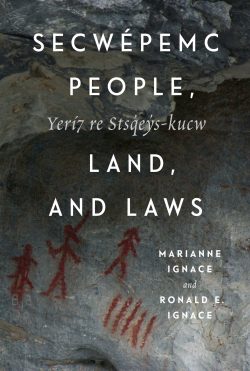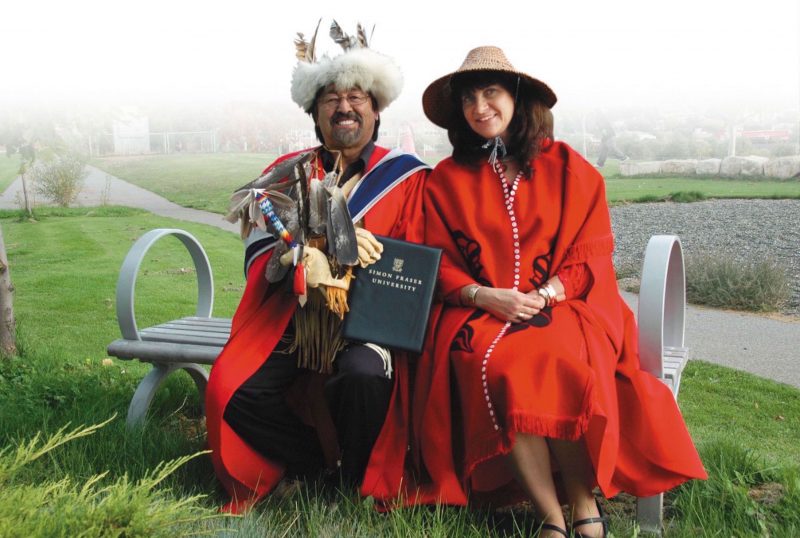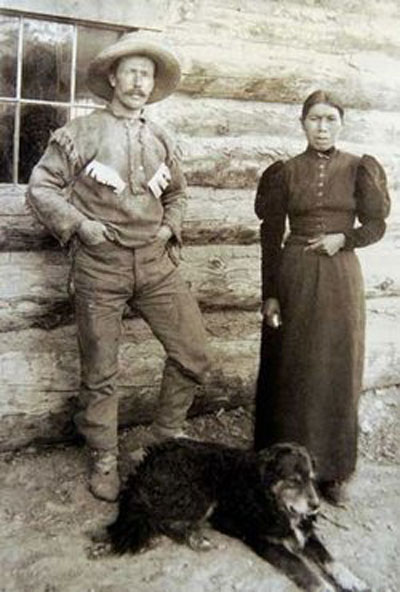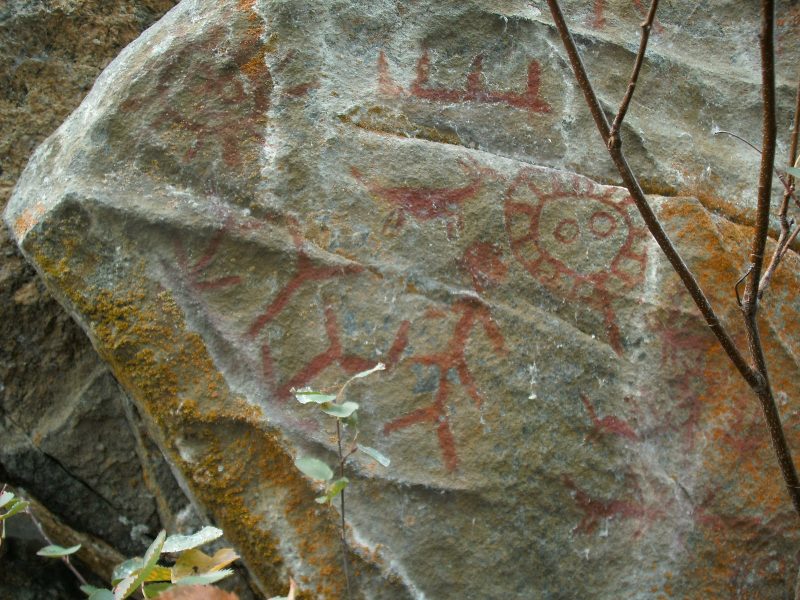#259 Celebrate Secwépemc Shuswap
Secwépemc People, Land, and Laws: Yerí7 Stsq̓ey̓s-kucw
by Marianne Ignace and Ronald Ignace
Montreal & Kingston: McGill-Queens University Press, 2017
$39.95 / 9780773551305
Reviewed by Sarah A. Nickel
First published March 5, 2018
*
 Secwépemc People, Land, and Laws: Yerí7 Stsq̓ey̓s-kucw (McGill-Queen’s University Press), by Marianne Ignace and Ronald Ignace, is a long-awaited study of the culture, territory, and history of the Secwépemc (pronounced Seck-wep-um), previously the Shuswap Nation.
Secwépemc People, Land, and Laws: Yerí7 Stsq̓ey̓s-kucw (McGill-Queen’s University Press), by Marianne Ignace and Ronald Ignace, is a long-awaited study of the culture, territory, and history of the Secwépemc (pronounced Seck-wep-um), previously the Shuswap Nation.
“Secwépemc People, Land, and Laws will not only become known as the Secwépemc encyclopedia,” concludes our reviewer Sarah Nickel, “but also sets the new gold standard for Indigenous scholarship.”
She describes this as a work of inspiring oral history research that reflects a lifetime of work with Secwépemc narrators, highlighting kinship and community relationships. Evidently the three judges for this year’s Basil Stuart-Stubbs Prize agree.
UBC Library has announced the sixth “Bazzie” will presented to the husband-and-wife team of Marianne Ignace and Ronald Ignace for Secwépemc People, Land, and Laws.
Runners-up this year are Unbuilt Environments: Tracing Postwar Development in Northwest British Columbia by Jonathan Peyton (UBC Press) and the editorial team of Richard J. Hebda, Sheila Greer, and Alexander Mackie for Kwädąy Dän Ts’ìnchį: Teachings from Long Ago Person Found (Victoria: Royal BC Museum Press).
The Basil Stuart-Stubbs Prize for Outstanding Scholarly Book on British Columbia was established in memory of Basil Stuart-Stubbs, a bibliophile, scholar and librarian who passed away in 2012.
For another review of Secwépemc People, Land, and Laws: Yerí7 Stsq̓ey̓s-kucw, see here – Ed.
*
10,000 years of Secwépemc presence

Secwépemc People, Land, and Laws is one of those books you anticipate long before it’s released and struggle to put down once it arrives. It is a weighty book — both in terms of its length and its significance.
As a Secwépemc person who teaches Indigenous Studies and history, the impact of this book has been both personal and scholarly. On a personal level, seeing family members’ names and faces threaded throughout this work was a deeply emotional experience.
From an academic perspective, this book offers a remarkable breadth and depth of information on the Secwépemc peoples, unrivalled elsewhere. Few Indigenous communities are lucky enough to have what the Secwépemc people now have: a comprehensive volume of the history, language, culture, and laws of our people — steeped in the rich multidisciplinary materials of archaeology, Indigenous oral tradition, ecology, linguistics, geology, anthropology, and history.

Representing 10,000 years of Secwépemc presence in the Interior plateau region of British Columbia through Indigenous perspectives, sources, and approaches, Secwépemc People, Land, and Laws will not only become known as the Secwépemc encyclopedia, but also sets the new gold standard for Indigenous scholarship.
Secwépemc People, Land, and Laws is organized into fourteen largely chronological and thematic chapters, each of which explores a remarkable range of topics in ancient and more recent Secwépemc history, including oral histories, population fluctuations, and changes to the land (Chapters 1 to 3); language (Chapter 4), Secwépemc resource use, stewardship, and trade (Chapters 5 and 6); Secwépemc sense of place, geographies, and boundary maintenance (Chapters 7 and 8); kinship, political organization, and spirituality (Chapters 9 to 11); and colonial change and Indigenous resistance (Chapters 12 and 13).

This work easily stands to replace well-worn copies of James Teit’s 1909 ethnography The Shuswap vol. II, part VII — a valued resource that, until now, was the most in-depth source of Secwépemc historical accounts and oral traditions — but one deeply implicated by the damaging tradition of salvage ethnography. For many Secwépemc, and other Indigenous peoples, settler-produced ethnographies like Teit’s were the main (if imperfect) entry point into understanding our history and culture. But now we have an alternative.
While Teit and his contemporaries attempted to salvage pre-contact societies, later histories focused intently on contact and its implications. The Ignaces, however, reject this binary. This is not a romanticized narrative of a pre-contact past, nor is colonialism the centre point around which everything is oriented. Instead, as the title suggests, Secwépemc people, land, and laws (in their varied expressions across time and space) are the focal point here, and while the Ignaces do not ignore the change wrought by European contact and settler expansion, they refuse to define Secwépemc peoples in either idealized (and ultimately inaccurate images) or purely in relation to colonial agents.
In both content and approach the authors offer an impressive example of decolonized, collaborative, community-engaged work. Significantly, they prove — beyond doubt — that so-called western and Indigenous knowledge can easily co-exist. In Chapter 2, for instance, the Ignaces “present a composite picture of ancient past events between 11,000 and 3,500 years ago, based on converging lines of evidence from earth science, paleoecology, and linguistics, triangulated with Secwépemc oral histories and with archaeological information.…” (p. 31).

They expertly demonstrate how geological evidence of a “single cataclysmic event” 9,750 years ago (which saw a Fraser River ice dam break and reverse the flow of the Thompson River system), is likewise documented in stsptékwll (Secwépemc oral traditions). There is no either/or account here — where Indigenous knowledge is judged for its accuracies — but rather a synergy of information from different but equal sources and epistemologies.
Further, geological change is not merely linked to natural events, but through stsptékwll, we learn of the role ancient transformers had on shaping Secwépemc landscapes as well. Through all of this the authors unapologetically reject the false subjective/objective, western/Indigenous binaries and hierarchies that have trailed Indigenous ways of knowing for generations.
The Ignaces also demonstrate what’s possible when Indigenous peoples write their own histories using their own generations of situated knowledge, their own languages, customs, and means of passing knowledge between generations (in addition to existing non-Indigenous tools). Secwépemc People, Land, and Laws represents community-engaged research at its best. The pages are thick with oral traditions, as well as contemporary and historical reminiscences from almost 150 Secwépemc peoples representing each of the seventeen communities (though some of communities are naturally more well-represented due to the authors’ connections and knowledge bases, as well as the existing records).
This inspiring oral history research reflects a lifetime of work with Secwépemc narrators and highlights the kinship and community relationships. Importantly, in these pages, Secwépemc peoples are not mere sources of information, mined for their academic and cultural capital, but equal partners, directing the nature and outcomes of this research. The Ignaces’ collaborative and multidisciplinary approach is likewise mirrored in academic partnerships and co-authorship with archaeologist Mike Rousseau, ethnobotanist Nancy Turner, and geographer Kenneth Favrholdt, who bring essential insights to discussions of Secwépemc archaeological traditions, resource use, and trading practices.
The extraneous materials, which include images of landscape, physical formations, archaeological artifacts, and peoples, as well as maps, genealogies, and archival materials, transport the reader, offering an in-depth look at the changing landscape of Secwepemculcw throughout geological shifts, migrations, warfare, trade, and colonial encounter.
I was especially struck by the authors’ discussions of Secwépemc nationhood and boundary maintenance (Chapter 8) through the simultaneous use of maps created by early European visitors (usually fur traders, known as seme7úw̓i or “real whites”), Secwépemc physical landmarks and markings, and oral histories.

The chapter begins with images of Pillar Rock (north of Falkland), “a story site and boundary marker between the Secwépemc and the Syilx,” and Coyote’s Sweathouse (near Alexis Creek), “an old boundary marker between the Secwépemc and Tsilhqot’in (pp. 262-263), both of which demonstrate historic Secwépemc mapping systems and the ways boundaries were marked and recognized across the Interior plateau.

Then, using a critical Indigenous lens, the authors read maps of David Thompson (1792-1812), Archibald McDonald (1827), Alexander Caulfield Anderson (1867), George Mercer Dawson (1891), and James Teit (1909) alongside Secwépemc knowledge to determine the maps’ accuracy and what they revealed about settler perceptions of the Secwépemc and their neighbouring tribes.
Offering corrections or a decolonized interpretation of the sources, the authors suggest many of the maps are “inaccurate, incomplete, or inconsistent,” in terms of depicting the details of Secwépemc communities, their lands, and boundaries (pp. 267-269). They do concede, however, that the maps provide useful information for naming some Secwépemc divisions and understanding approximate historical boundaries.
Once again, settler-produced sources are placed on par with and in direct relationship to Indigenous frameworks, and prove that both are needed to explore the vast and diverse Secwépemc territory.
Secwépemc laws also play a pivotal role in this work, and readers might be surprised at the ways in which, like oral sources, references to and expressions of law are threaded throughout the chapters and embedded in the materials rather than explicitly signaled and separated. For instance, there is no single chapter dedicated specifically to Secwépemc laws, where legal frameworks and orders are systematically defined and described. Rather, legal principles and responsibilities are revealed through stories, landscapes, and in peoples’ relationships with one another.

Chapter 1 highlights the role ancient stories and markings on the lands, including rock paintings, pictographs, and place names (often referred to as stsqey) play in understanding Secwépemc laws. “The ancient markings on the land,” the authors suggest, “supported by the stories connected to them, symbolize Secwepemc ‘law’” — including laws of sovereignty, the laws of access and rights to resources, and the law of making treaties among nations (p. 59). Secwépemc People, Land, and Laws therefore provides a detailed legal resource of Indigenous laws on an Indigenous people’s own terms, and itself serves as a strong articulation of Secwépemc laws.

This book truly has something for everyone. It will appeal widely to scholars in the fields of history, Indigenous Studies, law, archaeology, anthropology, linguistics, geology, and ecology. Though it is dense at times, it is also accessibly written, and should be required reading for anyone interested in the Indigenous histories of British Columbia. I will treasure this book as a family heirloom, but I will also be using it to teach Indigenous Studies research methods and Indigenous history, and to provide an aspirational example of what Indigenous community-engaged, decolonized scholarship can look like. And for this I am deeply indebted to the Ignaces for their lifetime of work.
*

Sarah Nickel (Ph.D, History, Simon Fraser University) is Tk’emlupsemc (Kamloops Secwepemc), French Canadian, and Ukrainian, and she grew up in the unceded lands of northern Secwepemcul’ecw and the xwməθkwəy̓əm (Musqueam), Skwxwú7mesh (Squamish), Stó:lō and Səl̓ílwətaʔ/Selilwitulh (Tsleil-Waututh) Nations. Sarah joined the Department of Indigenous Studies, situated in Treaty 6 territory and the homeland of the Metis in July 2015. Her areas of research include comparative Indigenous histories, twentieth century Indigenous politics, Indigenous women’s politics, Indigenous feminisms, community-engaged research, and oral history. Her most recent article, “I am not a women’s libber although sometimes I sound like one”: Indigenous Feminism and Politicized Motherhood, appeared in American Indian Quarterly in Fall 2017, and she has also published in BC Studies and Oral History Forum. Sarah’s first monograph, Negotiating Unity: Indigenous Politics and the Union of BC Indian Chiefs will be released by UBC Press in Fall 2018 and she is currently co-editing a volume on Indigenous feminisms with the University of Manitoba Press.
*
The Ormsby Review. More Readers. More Reviews. More Often.
Reviews Editor: Richard Mackie
Reviews Publisher: Alan Twigg — BC BookWorld / ABCBookWorld / BCBookLook / BC BookAwards / The Literary Map of B.C. / The Ormsby Review
The Ormsby Review is a new journal for serious coverage of B.C. literature and other arts. It is hosted by Simon Fraser University. The Advisory Board consists of Jean Barman, Robin Fisher, Cole Harris, Wade Davis, Hugh Johnston, Patricia Roy, David Stouck, and Graeme Wynn.
“Only connect. ” – E.M. Forster

Comments are closed.